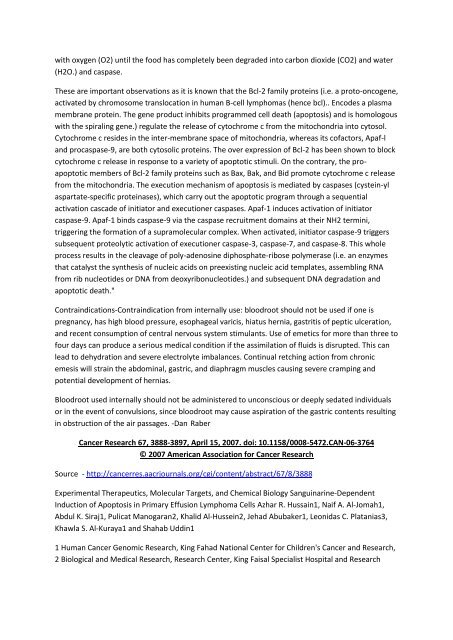Black Salve Alternative Cancer Treatment (1)
Create successful ePaper yourself
Turn your PDF publications into a flip-book with our unique Google optimized e-Paper software.
with oxygen (O2) until the food has completely been degraded into carbon dioxide (CO2) and water<br />
(H2O.) and caspase.<br />
These are important observations as it is known that the Bcl-2 family proteins (i.e. a proto-oncogene,<br />
activated by chromosome translocation in human B-cell lymphomas (hence bcl).. Encodes a plasma<br />
membrane protein. The gene product inhibits programmed cell death (apoptosis) and is homologous<br />
with the spiraling gene.) regulate the release of cytochrome c from the mitochondria into cytosol.<br />
Cytochrome c resides in the inter-membrane space of mitochondria, whereas its cofactors, Apaf-l<br />
and procaspase-9, are both cytosolic proteins. The over expression of Bcl-2 has been shown to block<br />
cytochrome c release in response to a variety of apoptotic stimuli. On the contrary, the proapoptotic<br />
members of Bcl-2 family proteins such as Bax, Bak, and Bid promote cytochrome c release<br />
from the mitochondria. The execution mechanism of apoptosis is mediated by caspases (cystein-yl<br />
aspartate-specific proteinases), which carry out the apoptotic program through a sequential<br />
activation cascade of initiator and executioner caspases. Apaf-1 induces activation of initiator<br />
caspase-9. Apaf-1 binds caspase-9 via the caspase recruitment domains at their NH2 termini,<br />
triggering the formation of a supramolecular complex. When activated, initiator caspase-9 triggers<br />
subsequent proteolytic activation of executioner caspase-3, caspase-7, and caspase-8. This whole<br />
process results in the cleavage of poly-adenosine diphosphate-ribose polymerase (i.e. an enzymes<br />
that catalyst the synthesis of nucleic acids on preexisting nucleic acid templates, assembling RNA<br />
from rib nucleotides or DNA from deoxyribonucleotides.) and subsequent DNA degradation and<br />
apoptotic death."<br />
Contraindications-Contraindication from internally use: bloodroot should not be used if one is<br />
pregnancy, has high blood pressure, esophageal varicis, hiatus hernia, gastritis of peptic ulceration,<br />
and recent consumption of central nervous system stimulants. Use of emetics for more than three to<br />
four days can produce a serious medical condition if the assimilation of fluids is disrupted. This can<br />
lead to dehydration and severe electrolyte imbalances. Continual retching action from chronic<br />
emesis will strain the abdominal, gastric, and diaphragm muscles causing severe cramping and<br />
potential development of hernias.<br />
Bloodroot used internally should not be administered to unconscious or deeply sedated individuals<br />
or in the event of convulsions, since bloodroot may cause aspiration of the gastric contents resulting<br />
in obstruction of the air passages. -Dan Raber<br />
<strong>Cancer</strong> Research 67, 3888-3897, April 15, 2007. doi: 10.1158/0008-5472.CAN-06-3764<br />
© 2007 American Association for <strong>Cancer</strong> Research<br />
Source - http://cancerres.aacrjournals.org/cgi/content/abstract/67/8/3888<br />
Experimental Therapeutics, Molecular Targets, and Chemical Biology Sanguinarine-Dependent<br />
Induction of Apoptosis in Primary Effusion Lymphoma Cells Azhar R. Hussain1, Naif A. Al-Jomah1,<br />
Abdul K. Siraj1, Pulicat Manogaran2, Khalid Al-Hussein2, Jehad Abubaker1, Leonidas C. Platanias3,<br />
Khawla S. Al-Kuraya1 and Shahab Uddin1<br />
1 Human <strong>Cancer</strong> Genomic Research, King Fahad National Center for Children's <strong>Cancer</strong> and Research,<br />
2 Biological and Medical Research, Research Center, King Faisal Specialist Hospital and Research



